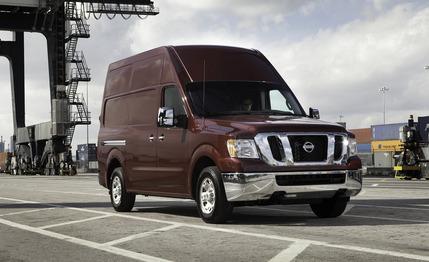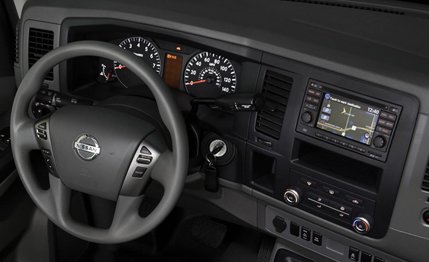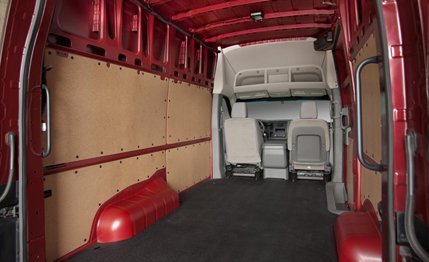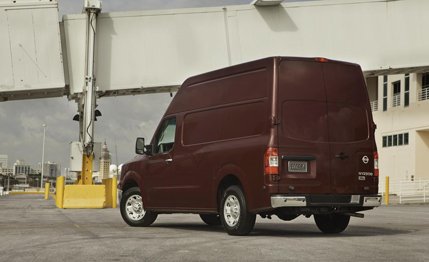 Short Take Road Test
Short Take Road Test
Nissan has been full of little surprises in the utility-vehicle realm lately—the Rogue, the Cube, the Juke—and here’s another, although the word “little” doesn’t apply in the case of the NV cargo van. Not when the subject vehicle stands 105 inches tall, with a cargo hold capable of swallowing a couple of basketball teams—or maybe three or four juvenile giraffes—standing at full height.

The surprises here are multiple: first, that Nissan chose to play in this game at all. The full-size-van market amounts to about 300,000 units in most years (although it dipped sharply in 2008 and ’09), and it’s dominated by Ford (about 50 percent) and General Motors (around 45 percent). The Sprinter, which has been sold here wearing Mercedes-Benz, Dodge, and Freightliner badges, has hitherto been the only tall van in this segment and accounts for the other five percent. So, it’s a relatively small market that is 95-percent owned by domestic makes whose loyal customers are hard to seduce. Apparently, Nissan took that as a challenge.
Another surprise is that Nissan chose to create a dedicated chassis for its new van. Aside from one crossmember, the NV’s fully boxed ladder frame—it looks as if it could have been sectioned out of New York’s 59th Street Bridge—shares nothing with the Titan pickup. That’s a lot of investment for what figures to be a small slice of a modest market, although we do expect Nissan to utilize this frame for a heavy-duty Titan or the next generation of the regular-strength pickup.
Pickup Power
Although the underpinnings are new, the powertrains are familiar, as both are from the Nissan pickup inventory. The base van with the high or standard roof is propelled by a 4.0-liter V-6 (261 hp, 281 lb-ft of torque) from the mid-size Frontier. The optional engine is the Titan’s 5.6-liter V-8 (317 hp, 385 lb-ft), which is standard in the top-spec 3500 and powered the example tested here. Both engines transmit power to the rear wheels via a five-speed automatic transmission. There is no four-wheel-drive option.

At the test track, this powertrain plus a 6220-pound curb weight added up to a 0-to-60-mph time of 8.4 seconds—not exactly thrilling, but much quicker than the 11.6 seconds recorded by the last Sprinter we tested. The NV also trumped the Sprinter’s passing times: 4.2 and 5.9 seconds to accelerate from 30 mph to 50 and 50 to 70, respectively, compared with 5.7 and 9.0 seconds. There didn’t seem to be much degradation when we hooked up some 4500 pounds of trailer and race car and loaded a few hundred pounds of spares inside, either.
Engine performance, then, is pretty good for a vehicle in this size and weight class, and fuel economy is about what you’d expect. The EPA doesn’t require mpg ratings for vehicles with a gross vehicle weight rating (GVWR) above 8500 pounds, and the NV tested here carries a 9100-pound GVWR. We logged 11 mpg during the van’s two-week stay—not impressive, but that did include almost 400 miles of towing to and from GingerMan Raceway in western Michigan.
Deliberate Dynamics
This van’s dynamics also are what you’d expect. The suspension manages that towering aspect ratio surprisingly well, but this isn’t the kind of rig you take to your weekend autocross. The steering is slow—4.0 turns lock-to-lock—and transient responses tend toward ponderous.

On the other hand, although the 192 feet the NV needed to stop from 70 mph might be two more than the Sprinter needed, that figure is actually as good as the average three-row kid hauler’s and well ahead of the NV’s workhorse brethren in the heavy-duty-truck class. The brakes are discs all around, and ABS is standard equipment. The Nissan’s ride quality is surprisingly smooth for a big van with spring rates selected for heavy loads, and the NV is quiet at highway speeds, considering its cargo-space acoustics rival those of a railroad depot. The optional sound system is respectable for a vehicle of this type, and there’s an iPod jack, as well as a USB port.
Nissan chose not to include a provision for wireless internet connectivity like the Ford Transit Connect does. On the other hand, the cavernous center console will swallow a laptop, files, and all sorts of other stuff that might be useful to a commercial-van driver.
Priced to Sell
Base prices for a standard-roof NV range from $25,570 for the base V-6 1500 model to $30,770 for the 3500 HD SV, giving Nissan’s standard vans pricing parity with domestic equivalents. Although the NV lacks a diesel option, as well as the range of body sizes offered by the Sprinter line, it does come to market with a price schedule that undercuts its high-roof competition by a significant margin. Our test unit—a well-equipped 2500 HD SV high-roof model, had a base price of $31,470. Optional equipment included the $950 Technology package (nav system with traffic alerts, rearview camera, Bluetooth, USB and auxiliary audio inputs, XM radio); the $460 Towing package (Class IV hitch, extendable heated side mirrors, trailer-brake controller prewiring, front tow hooks, HD battery); and a $390 airbag package (seat-mounted side airbags, roof-mounted curtain air bags).

The as-tested total came to $33,270, more than $3000 cheaper than the most basic Sprinter’s price of entry. Base prices for the Mercedes van soar to more than $43,000 for a long-wheelbase version. Nissan’s product planners seem to have fixed their marketing crosshairs directly on the big Benz, but is that target large enough to ensure success? We can’t say. What we can say is that those who do opt for the NV will be very pleased with Nissan’s latest non sequitur.